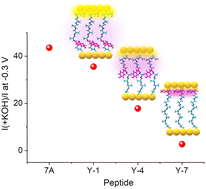Electron transport via tyrosine-doped oligo-alanine peptide junctions: role of charges and hydrogen bonding†
Abstract
A way of modulating the solid-state electron transport (ETp) properties of oligopeptide junctions is presented by charges and internal hydrogen bonding, which affect this process markedly. The ETp properties of a series of tyrosine (Tyr)-containing hexa-alanine peptides, self-assembled in monolayers and sandwiched between gold electrodes, are investigated in response to their protonation state. Inserting a Tyr residue into these peptides enhances the ETp carried via their junctions. Deprotonation of the Tyr-containing peptides causes a further increase of ETp efficiency that depends on this residue's position. Combined results of molecular dynamics simulations and spectroscopic experiments suggest that the increased conductance upon deprotonation is mainly a result of enhanced coupling between the charged C-terminus carboxylate group and the adjacent Au electrode. Moreover, intra-peptide hydrogen bonding of the Tyr hydroxyl to the C-terminus carboxylate reduces this coupling. Hence, the extent of such a conductance change depends on the Tyr-carboxylate distance in the peptide's sequence.



 Please wait while we load your content...
Please wait while we load your content...